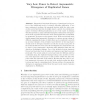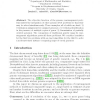RECOMB
2005
Springer
14 years 12 months ago
2005
Springer
As one of the earliest problems in computational biology, RNA secondary structure prediction (sometimes referred to as "RNA folding") problem has attracted attention agai...
RECOMB
2005
Springer
14 years 12 months ago
2005
Springer
Recombination is an important evolutionary mechanism responsible for the genetic diversity in humans and other organisms. Recently, there has been extensive research on understandi...
RECOMB
2005
Springer
14 years 12 months ago
2005
Springer
We describe a novel method for efficient reconstruction of phylogenetic trees, based on sequences of whole genomes or proteomes, whose lengths may greatly vary. The core of our me...
RECOMB
2005
Springer
14 years 12 months ago
2005
Springer
Abstract. Recent studies demonstrating the existence of special non-coding "antisense" RNAs used in post-transcriptional gene regulation have received considerable attent...
RECOMB
2005
Springer
14 years 12 months ago
2005
Springer
Abstract. Gene rearrangements have been used successfully in phylogenetic reconstruction and comparative genomics, but usually under the assumption that all genomes have the same g...
RECOMB
2005
Springer
14 years 12 months ago
2005
Springer
Abstract. Asymmetric functional divergence of paralogues is a key aspect of the traditional model of evolution following duplication. If one gene continues to perform the ancestral...
RECOMB
2005
Springer
14 years 12 months ago
2005
Springer
Abstract. The objective function of the genome rearrangement problems allows the integration of other genome-level problems so that they may be solved simultaneously. Three example...
RECOMB
2005
Springer
14 years 12 months ago
2005
Springer
Abstract. Gene cluster significance tests that are based on the number of genes in a cluster in two genomes, and how compactly they are distributed, but not their order, may be mad...
RECOMB
2005
Springer
14 years 12 months ago
2005
Springer
Abstract. Identification of homologous chromosomal regions is important for understanding evolutionary processes that shape genome evolution, such as genome rearrangements and larg...
RECOMB
2005
Springer
14 years 12 months ago
2005
Springer
In the half-century since the C-value paradox (the apparent lack of correlation between organismal genome size and morphological complexity) was described, there have been no expli...






